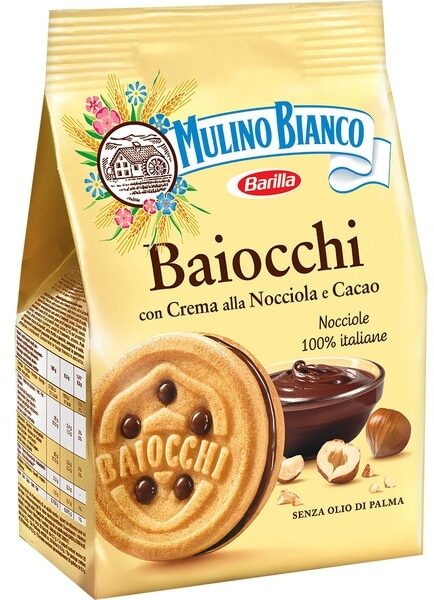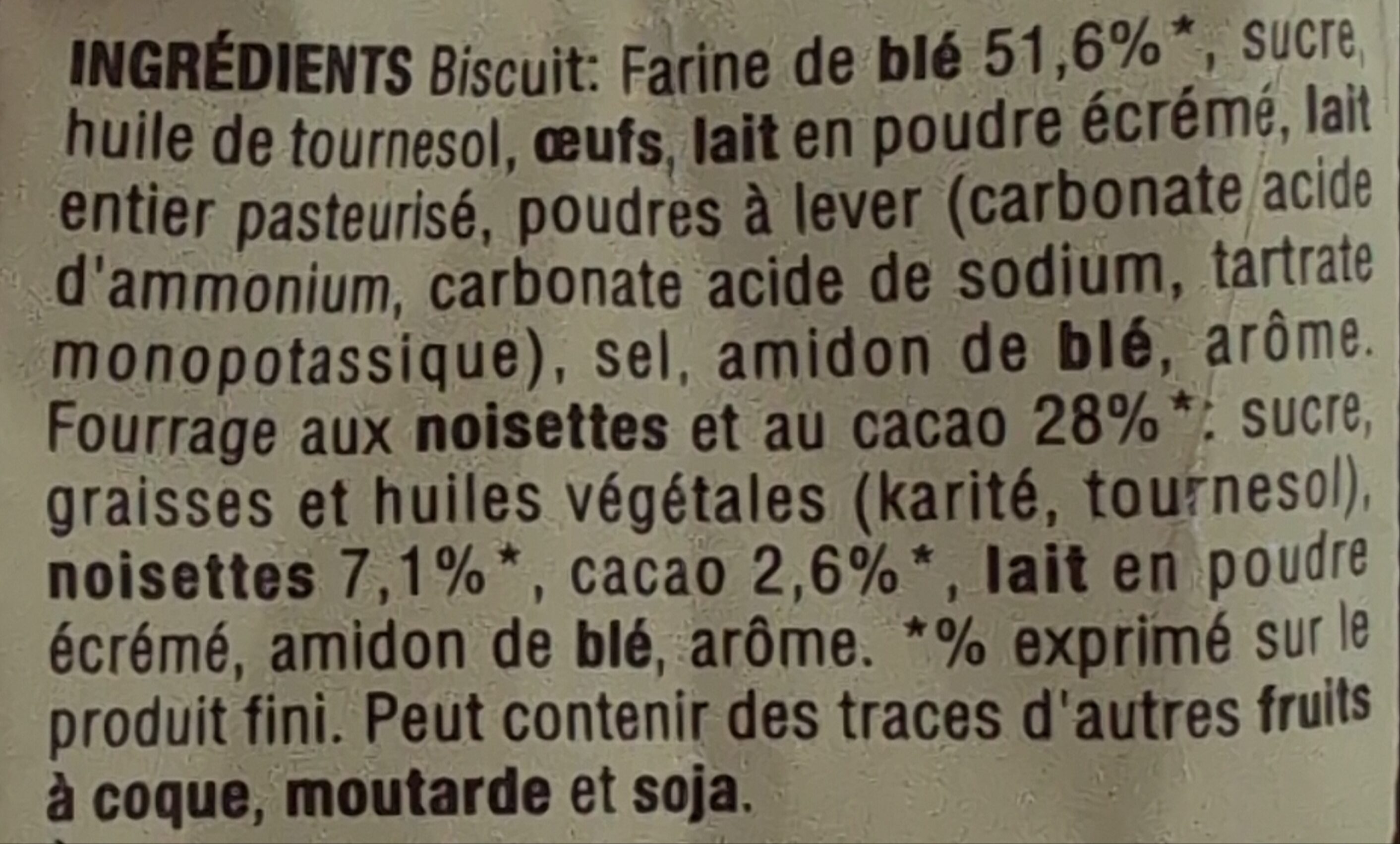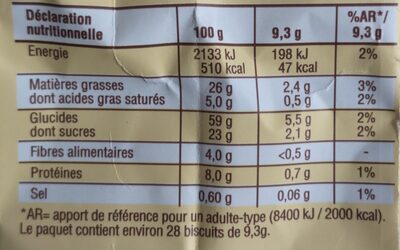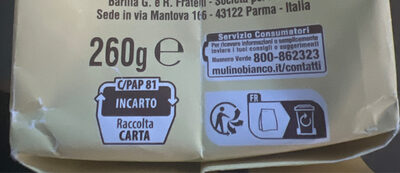Help us make food transparency the norm!
As a non-profit organization, we depend on your donations to continue informing consumers around the world about what they eat.
The food revolution starts with you!
Baiocchi - Mulino Bianco - 260g, 28 biscuits
Baiocchi - Mulino Bianco - 260g, 28 biscuits
Barcode: 8076809573252 (EAN / EAN-13)
Allgemengen Numm:: Biscuit fourrés aux noisettes et cacao
Quantitéit: 260g, 28 biscuits
Verpackungsart: en:Bag
Marken: Mulino Bianco
Kategorien: en:Snacks, en:Sweet snacks, en:Biscuits and cakes, en:Biscuits, en:Chocolate biscuits, en:Shortbread cookies, fr:Biscuits-avec-fourrage-aux-noisettes-et-au-cacao
Labelen, Zertifizéierungen, Auszeechnungen:
en:Green Dot, en:No palm oil, Triman

Ursprong vun den Zutaten: fr:noisettes origine Italie
Geschäfter: Magasins U, Lidl, carrefour.fr, Ocado
Country: Frankräich, Däitschland, Italien, Spuenien, Schwäiz
Matching with your preferences
Health
Inhaltstoffer
-
23 ingredients
Franséisch: Biscuit: Farine de blé 51,6%*, sucre, huile de tournesol, œufs, lait en poudre écrémé, lait entier pasteurisé, poudres à lever (carbonate acide d'ammonium, carbonate acide de sodium, tartrate monopotassique), sel, amidon de blé, arôme. Fourrage aux noisettes et au cacao 28%* : sucre, graisses et huiles végétales (karité, tournesol), noisettes 7,1%*, cacao 2,6%*, lait en poudre écrémé, amidon de blé, arôme. *% exprimé sur le produit fini. Peut contenir des traces d'autres fruits à coque, moutarde et soja.Allergenen: en:Eggs, en:Gluten, en:NutsTraces: en:Mustard, en:Nuts, en:Peanuts, en:Sesame seeds, en:Soybeans
Food processing
-
Ultra processed foods
Elements that indicate the product is in the en:4 - Ultra processed food and drink products group:
- Inhaltstoffer: Flavouring
Food products are classified into 4 groups according to their degree of processing:
- Unprocessed or minimally processed foods
- Processed culinary ingredients
- Processed foods
- Ultra processed foods
The determination of the group is based on the category of the product and on the ingredients it contains.
Zousätz
-
E336
Potassium tartrate: Potassium tartrate, dipotassium tartrate or argol has formula K2C4H4O6. It is the potassium salt of tartaric acid. It is often confused with potassium bitartrate, also known as cream of tartar. As a food additive, it shares the E number E336 with potassium bitartrate.Source: Wikipedia (Englesch)
-
E336i
Potassium tartrate: Potassium tartrate, dipotassium tartrate or argol has formula K2C4H4O6. It is the potassium salt of tartaric acid. It is often confused with potassium bitartrate, also known as cream of tartar. As a food additive, it shares the E number E336 with potassium bitartrate.Source: Wikipedia (Englesch)
-
E500
Sodium carbonate: Sodium carbonate, Na2CO3, -also known as washing soda, soda ash and soda crystals, and in the monohydrate form as crystal carbonate- is the water-soluble sodium salt of carbonic acid. It most commonly occurs as a crystalline decahydrate, which readily effloresces to form a white powder, the monohydrate. Pure sodium carbonate is a white, odorless powder that is hygroscopic -absorbs moisture from the air-. It has a strongly alkaline taste, and forms a moderately basic solution in water. Sodium carbonate is well known domestically for its everyday use as a water softener. Historically it was extracted from the ashes of plants growing in sodium-rich soils, such as vegetation from the Middle East, kelp from Scotland and seaweed from Spain. Because the ashes of these sodium-rich plants were noticeably different from ashes of timber -used to create potash-, they became known as "soda ash". It is synthetically produced in large quantities from salt -sodium chloride- and limestone by a method known as the Solvay process. The manufacture of glass is one of the most important uses of sodium carbonate. Sodium carbonate acts as a flux for silica, lowering the melting point of the mixture to something achievable without special materials. This "soda glass" is mildly water-soluble, so some calcium carbonate is added to the melt mixture to make the glass produced insoluble. This type of glass is known as soda lime glass: "soda" for the sodium carbonate and "lime" for the calcium carbonate. Soda lime glass has been the most common form of glass for centuries. Sodium carbonate is also used as a relatively strong base in various settings. For example, it is used as a pH regulator to maintain stable alkaline conditions necessary for the action of the majority of photographic film developing agents. It acts as an alkali because when dissolved in water, it dissociates into the weak acid: carbonic acid and the strong alkali: sodium hydroxide. This gives sodium carbonate in solution the ability to attack metals such as aluminium with the release of hydrogen gas.It is a common additive in swimming pools used to raise the pH which can be lowered by chlorine tablets and other additives which contain acids. In cooking, it is sometimes used in place of sodium hydroxide for lyeing, especially with German pretzels and lye rolls. These dishes are treated with a solution of an alkaline substance to change the pH of the surface of the food and improve browning. In taxidermy, sodium carbonate added to boiling water will remove flesh from the bones of animal carcasses for trophy mounting or educational display. In chemistry, it is often used as an electrolyte. Electrolytes are usually salt-based, and sodium carbonate acts as a very good conductor in the process of electrolysis. In addition, unlike chloride ions, which form chlorine gas, carbonate ions are not corrosive to the anodes. It is also used as a primary standard for acid-base titrations because it is solid and air-stable, making it easy to weigh accurately.Source: Wikipedia (Englesch)
-
E500ii
Sodium carbonate: Sodium carbonate, Na2CO3, -also known as washing soda, soda ash and soda crystals, and in the monohydrate form as crystal carbonate- is the water-soluble sodium salt of carbonic acid. It most commonly occurs as a crystalline decahydrate, which readily effloresces to form a white powder, the monohydrate. Pure sodium carbonate is a white, odorless powder that is hygroscopic -absorbs moisture from the air-. It has a strongly alkaline taste, and forms a moderately basic solution in water. Sodium carbonate is well known domestically for its everyday use as a water softener. Historically it was extracted from the ashes of plants growing in sodium-rich soils, such as vegetation from the Middle East, kelp from Scotland and seaweed from Spain. Because the ashes of these sodium-rich plants were noticeably different from ashes of timber -used to create potash-, they became known as "soda ash". It is synthetically produced in large quantities from salt -sodium chloride- and limestone by a method known as the Solvay process. The manufacture of glass is one of the most important uses of sodium carbonate. Sodium carbonate acts as a flux for silica, lowering the melting point of the mixture to something achievable without special materials. This "soda glass" is mildly water-soluble, so some calcium carbonate is added to the melt mixture to make the glass produced insoluble. This type of glass is known as soda lime glass: "soda" for the sodium carbonate and "lime" for the calcium carbonate. Soda lime glass has been the most common form of glass for centuries. Sodium carbonate is also used as a relatively strong base in various settings. For example, it is used as a pH regulator to maintain stable alkaline conditions necessary for the action of the majority of photographic film developing agents. It acts as an alkali because when dissolved in water, it dissociates into the weak acid: carbonic acid and the strong alkali: sodium hydroxide. This gives sodium carbonate in solution the ability to attack metals such as aluminium with the release of hydrogen gas.It is a common additive in swimming pools used to raise the pH which can be lowered by chlorine tablets and other additives which contain acids. In cooking, it is sometimes used in place of sodium hydroxide for lyeing, especially with German pretzels and lye rolls. These dishes are treated with a solution of an alkaline substance to change the pH of the surface of the food and improve browning. In taxidermy, sodium carbonate added to boiling water will remove flesh from the bones of animal carcasses for trophy mounting or educational display. In chemistry, it is often used as an electrolyte. Electrolytes are usually salt-based, and sodium carbonate acts as a very good conductor in the process of electrolysis. In addition, unlike chloride ions, which form chlorine gas, carbonate ions are not corrosive to the anodes. It is also used as a primary standard for acid-base titrations because it is solid and air-stable, making it easy to weigh accurately.Source: Wikipedia (Englesch)
-
E503
Ammonium carbonate: Ammonium carbonate is a salt with the chemical formula -NH4-2CO3. Since it readily degrades to gaseous ammonia and carbon dioxide upon heating, it is used as a leavening agent and also as smelling salt. It is also known as baker's ammonia and was a predecessor to the more modern leavening agents baking soda and baking powder. It is a component of what was formerly known as sal volatile and salt of hartshorn.Source: Wikipedia (Englesch)
-
E503ii
Ammonium carbonate: Ammonium carbonate is a salt with the chemical formula -NH4-2CO3. Since it readily degrades to gaseous ammonia and carbon dioxide upon heating, it is used as a leavening agent and also as smelling salt. It is also known as baker's ammonia and was a predecessor to the more modern leavening agents baking soda and baking powder. It is a component of what was formerly known as sal volatile and salt of hartshorn.Source: Wikipedia (Englesch)
Analys vun den Inhaltstoffer
-
en:May contain palm oil
Ingredients that may contain palm oil: en:Fat
-
en:Non-vegan
Non-vegan ingredients: en:Egg, en:Skimmed milk powder, en:Pasteurised whole milk, en:Skimmed milk powderSome ingredients could not be recognized.
We need your help!
You can help us recognize more ingredients and better analyze the list of ingredients for this product and others:
- Edit this product page to correct spelling mistakes in the ingredients list, and/or to remove ingredients in other languages and sentences that are not related to the ingredients.
- Add new entries, synonyms or translations to our multilingual lists of ingredients, ingredient processing methods, and labels.
If you would like to help, join the #ingredients channel on our Slack discussion space and/or learn about ingredients analysis on our wiki. Thank you!
-
en:Vegetarian status unknown
Unrecognized ingredients: en:Biscuit, fr:fourrage-aux-noisettes-et-au-cacaoSome ingredients could not be recognized.
We need your help!
You can help us recognize more ingredients and better analyze the list of ingredients for this product and others:
- Edit this product page to correct spelling mistakes in the ingredients list, and/or to remove ingredients in other languages and sentences that are not related to the ingredients.
- Add new entries, synonyms or translations to our multilingual lists of ingredients, ingredient processing methods, and labels.
If you would like to help, join the #ingredients channel on our Slack discussion space and/or learn about ingredients analysis on our wiki. Thank you!
-
Details of the analysis of the ingredients
We need your help!
Some ingredients could not be recognized.
We need your help!
You can help us recognize more ingredients and better analyze the list of ingredients for this product and others:
- Edit this product page to correct spelling mistakes in the ingredients list, and/or to remove ingredients in other languages and sentences that are not related to the ingredients.
- Add new entries, synonyms or translations to our multilingual lists of ingredients, ingredient processing methods, and labels.
If you would like to help, join the #ingredients channel on our Slack discussion space and/or learn about ingredients analysis on our wiki. Thank you!
fr: Biscuit (Farine de blé 51.6%), sucre, huile de tournesol, œufs, lait en poudre écrémé, lait entier pasteurisé, poudres à lever (carbonate acide d'ammonium, carbonate acide de sodium, tartrate monopotassique), sel, amidon de blé, arôme, Fourrage aux noisettes et au cacao 28%, graisses, huiles végétales de karité, huiles végétales de tournesol, noisettes 7.1%, cacao 2.6%, lait en poudre écrémé, amidon de blé, arôme- Biscuit -> en:biscuit - ciqual_food_code: 24000
- Farine de blé -> en:wheat-flour - vegan: yes - vegetarian: yes - ciqual_proxy_food_code: 9410 - percent: 51.6
- sucre -> en:sugar - vegan: yes - vegetarian: yes - ciqual_proxy_food_code: 31016
- huile de tournesol -> en:sunflower-oil - vegan: yes - vegetarian: yes - from_palm_oil: no - ciqual_food_code: 17440
- œufs -> en:egg - vegan: no - vegetarian: yes - ciqual_food_code: 22000
- lait en poudre écrémé -> en:skimmed-milk-powder - vegan: no - vegetarian: yes - ciqual_food_code: 19054
- lait entier pasteurisé -> en:pasteurised-whole-milk - vegan: no - vegetarian: yes - ciqual_food_code: 19024
- poudres à lever -> en:raising-agent
- carbonate acide d'ammonium -> en:e503ii - vegan: yes - vegetarian: yes
- carbonate acide de sodium -> en:e500ii - vegan: yes - vegetarian: yes
- tartrate monopotassique -> en:e336 - vegan: yes - vegetarian: yes
- sel -> en:salt - vegan: yes - vegetarian: yes - ciqual_food_code: 11058
- amidon de blé -> en:wheat-starch - vegan: yes - vegetarian: yes - ciqual_proxy_food_code: 9510
- arôme -> en:flavouring - vegan: maybe - vegetarian: maybe
- Fourrage aux noisettes et au cacao -> fr:fourrage-aux-noisettes-et-au-cacao - percent: 28
- graisses -> en:fat - vegan: maybe - vegetarian: maybe - from_palm_oil: maybe
- huiles végétales de karité -> en:shea-butter - vegan: yes - vegetarian: yes - from_palm_oil: no - ciqual_food_code: 16110
- huiles végétales de tournesol -> en:sunflower-oil - vegan: yes - vegetarian: yes - from_palm_oil: no - ciqual_food_code: 17440
- noisettes -> en:hazelnut - vegan: yes - vegetarian: yes - ciqual_food_code: 15004 - percent: 7.1
- cacao -> en:cocoa - vegan: yes - vegetarian: yes - ciqual_proxy_food_code: 18100 - percent: 2.6
- lait en poudre écrémé -> en:skimmed-milk-powder - vegan: no - vegetarian: yes - ciqual_food_code: 19054
- amidon de blé -> en:wheat-starch - vegan: yes - vegetarian: yes - ciqual_proxy_food_code: 9510
- arôme -> en:flavouring - vegan: maybe - vegetarian: maybe
Ernährung
-
Poor nutritional quality
⚠ ️Warning: the amount of fruits, vegetables and nuts is not specified on the label, it was estimated from the list of ingredients: 7This product is not considered a beverage for the calculation of the Nutri-Score.
Positive points: 4
- Protéinen/Ëiweisser: 4 / 5 (value: 8, rounded value: 8)
- Fiber: 4 / 5 (value: 4, rounded value: 4)
- Fruits, vegetables, nuts, and colza/walnut/olive oils: 0 / 5 (value: 7.1, rounded value: 7.1)
Negative points: 22
- Energie: 6 / 10 (value: 2133, rounded value: 2133)
- Zocker: 10 / 10 (value: 213, rounded value: 213)
- Gesättescht Fetter: 4 / 10 (value: 5, rounded value: 5)
- Sodium: 2 / 10 (value: 240, rounded value: 240)
The points for proteins are not counted because the negative points are greater or equal to 11.
Nutritional score: (22 - 4)
Nutri-Score:
-
Nutrient levels
-
Fat in héich Quantitéit (26%)
What you need to know- A high consumption of fat, especially saturated fats, can raise cholesterol, which increases the risk of heart diseases.
Recommendation: Limit the consumption of fat and saturated fat- Choose products with lower fat and saturated fat content.
-
Saturated fat in moderate quantity (5%)
What you need to know- A high consumption of fat, especially saturated fats, can raise cholesterol, which increases the risk of heart diseases.
Recommendation: Limit the consumption of fat and saturated fat- Choose products with lower fat and saturated fat content.
-
Sugars in héich Quantitéit (213%)
What you need to know- A high consumption of sugar can cause weight gain and tooth decay. It also augments the risk of type 2 diabetes and cardio-vascular diseases.
Recommendation: Limit the consumption of sugar and sugary drinks- Sugary drinks (such as sodas, fruit beverages, and fruit juices and nectars) should be limited as much as possible (no more than 1 glass a day).
- Choose products with lower sugar content and reduce the consumption of products with added sugars.
-
Salt in moderate quantity (0.6%)
What you need to know- A high consumption of salt (or sodium) can cause raised blood pressure, which can increase the risk of heart disease and stroke.
- Many people who have high blood pressure do not know it, as there are often no symptoms.
- Most people consume too much salt (on average 9 to 12 grams per day), around twice the recommended maximum level of intake.
Recommendation: Limit the consumption of salt and salted food- Reduce the quantity of salt used when cooking, and don't salt again at the table.
- Limit the consumption of salty snacks and choose products with lower salt content.
-
-
Ernährungangaben
Ernährungangaben As sold
for 100 g / 100 mlAs sold
per serving (9.3g)Compared to: en:Chocolate biscuits Energie 2.133 kj
(510 kcal)198 kj
(47 kcal)+5 % Fat 26 g 2,42 g +10 % Saturated fat 5 g 0,465 g -59 % Carbohydrates 59 g 5,49 g -1 % Sugars 213 g 19,8 g +578 % Fiber 4 g 0,372 g +1 % Protein 8 g 0,744 g +21 % Salt 0,6 g 0,056 g +27 % Alkoholen 0 % vol 0 % vol Fruits‚ vegetables‚ nuts and rapeseed‚ walnut and olive oils (estimate from ingredients list analysis) 7,1 % 7,1 %
Environment
-
Eco-Score C - Moderate environmental impact
The Eco-Score is an experimental score that summarizes the environmental impacts of food products.→ The Eco-Score was initially developped for France and it is being extended to other European countries. The Eco-Score formula is subject to change as it is regularly improved to make it more precise and better suited to each country.Life cycle analysis
-
Average impact of products of the same category: B (Score: 70/100)
Kategorie: Shortbread pastry biscuit
Kategorie: Shortbread pastry biscuit
- PEF environmental score: 0.34 (the lower the score, the lower the impact)
- including impact on climate change: 2.98 kg CO2 eq/kg of product
Stage Impact Agriculture
79.8 %Processing
12.4 %Verpackungsart
3.2 %Transportation
3.2 %Distribution
1.4 %Consumption
0.0 %
Bonuses and maluses
-
Missing origins of ingredients information
Malus: -5
⚠ ️ The origins of the ingredients of this product are not indicated.
If they are indicated on the packaging, you can modify the product sheet and add them.
If you are the manufacturer of this product, you can send us the information with our free platform for producers.
-
Packaging with a medium impact
Malus: -10
Shape Material Recycling Impact 1 Bag 81 C/PAP Héich
Eco-Score for this product
-
Impact for this product: C (Score: 55/100)
Produkt: Baiocchi - Mulino Bianco - 260g, 28 biscuits
Life cycle analysis score: 70
Sum of bonuses and maluses: -15
Final score: 55/100
-
Carbon footprint
-
Equal to driving 1.5 km in a petrol car
298 g CO² per 100g of product
The carbon emission figure comes from ADEME's Agribalyse database, for the category: Shortbread pastry biscuit (Source: ADEME Agribalyse Database)
Stage Impact Agriculture
83.3 %Processing
7.8 %Verpackungsart
3.7 %Transportation
4.5 %Distribution
0.7 %Consumption
0.0 %
Verpackungsart
-
Packaging with a medium impact
-
Packaging parts
1 x Bag (81 C/PAP)
-
Packaging materials
Material % Packaging weight Packaging weight per 100 g of product
-
Transportation
-
Origins of ingredients
Missing origins of ingredients information
⚠ ️ The origins of the ingredients of this product are not indicated.
If they are indicated on the packaging, you can modify the product sheet and add them.
If you are the manufacturer of this product, you can send us the information with our free platform for producers.Add the origins of ingredients for this product Add the origins of ingredients for this product
Report a problem
-
Incomplete or incorrect information?
Category, labels, ingredients, allergens, nutritional information, photos etc.
If the information does not match the information on the packaging, please complete or correct it. Open Food Facts is a collaborative database, and every contribution is useful for all.
Data sources
Product added on vun kiliweb
Last edit of product page on vun raphael.
Produkt Säit och geännert vun amerigo, carlitocox, casacalvo, chevalstar, date-limite-app, desan, driveoff, ecoscore-impact-estimator, feat, gluten-scan, gmlaa, grumpf, hungergames, inf, magasins-u, marilyn, mvk, olasonfran, openfoodfacts-contributors, packbot, prepperapp, quechoisir, quentinbrd, scanbot, smoothie-app, sophiecool62, spotter, sylvia79, telperion87, teolemon, thaialagata, yuka.F51sB-axJss4M93ejYgo0huFMb3tJMQDPlQwog, yuka.RzRBaEhyWUVoUHBRb3ZBNDcwdjhvY2w1K29HRVdGR2xlODhWSVE9PQ, yuka.SDc4a1NmUU9nUFFQb01FQTl6SDJ5OWxJN29Hb2QwUzFldFJJSUE9PQ, yuka.VFlNNUxhUWhwZVVUbVBJaS9rbjExNElsMXFTblpXR1ZCZTR6SVE9PQ, yuka.WWJJYVN2OEJ2dGdya3RzMDRpbldvZkFzbmJpSEEwQ1pHYm9lSVE9PQ, yuka.WXFJSlNwWU11Nk1uZ3NJUzFENk0zTU1sbHBIMlREaVlHYkFXSVE9PQ, yuka.Wi9FK083OGRucWNveC9KbDlCWE4vL0IxbmJUMEEwYnJFZXczSVE9PQ, yuka.YTV3dUdiWUl1Tk1OcHYwdW93cnEydWtsM0tPcVExdUtBYzB3SVE9PQ, yuka.ZDQ0Y0RvZ0Roc0lUbi9Zbm95M3UzZTlNN0tDSVFsaTJCODlQSUE9PQ, yuka.sY2b0xO6T85zoF3NwEKvlkEbA9SDkz_PDjj5q1SWl-y3CcX3X9pevrDZbao.












